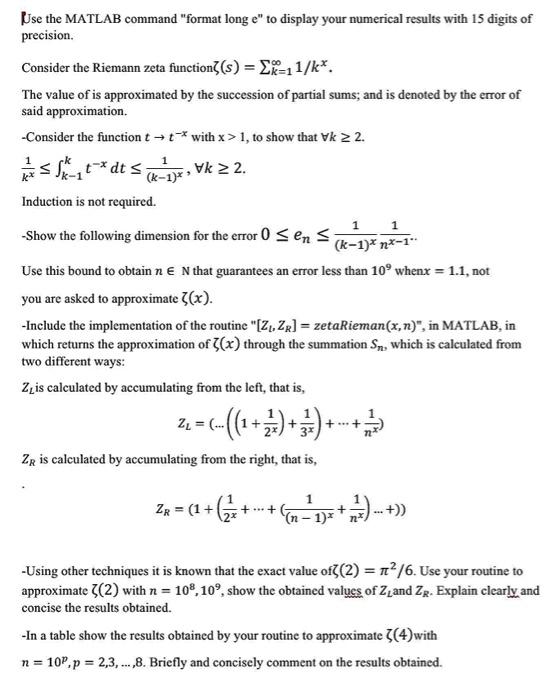Show code and explain each step
Show code and explain each step.

Use the MATLAB command "format long e" to display your numerical results with 15 digits of precision Consider the Riemann zeta function(s) = EK=11/k*. The value of is approximated by the succession of partial sums, and is denoted by the error of said approximation. -Consider the function t ++* with x > 1, to show that Uk > 2. .t-* dt = (k-1)** Vk 2. Induction is not required. -Show the following dimension for the error 0 Sens (k-1)*n*-1" Use this bound to obtain n E N that guarantees an error less than 10 whenx = 1.1, not you are asked to approximate (x). - Include the implementation of the routine "[2, 2p] = zetaRieman(x,n)", in MATLAB. in which returns the approximation of (x) through the summation Sn, which is calculated from two different ways: 2 is calculated by accumulating from the left, that is, 1 1 2L = (... (--((1+y)+5+) +- tema Zr is calculated by accumulating from the right, that is, 2x = (1 + (x+ +++ 1 (n-1)* +)) -Using other techniques it is known that the exact value ofg(2) = 1/6. Use your routine to approximate 3(2) with n = 108,109, show the obtained values of Z and Zg. Explain clearly and concise the results obtained. - In a table show the results obtained by your routine to approximate (4)with n = 10P.p = 2,3,...,8. Briefly and concisely comment on the results obtained. Ruse the MATLAB command "format long e" to display your numerical results with 15 digits of precision. Consider the Riemann zeta function(s) = EX=11/k*. The value of is approximated by the succession of partial sums; and is denoted by the error of said approximation. -Consider the function t ++-* with x > 1, to show that Vk 2 2. **dt sa-vx, Vk 22. Induction is not required. -Show the following dimension for the error 0 Sens (k-1)* nx-1" Use this bound to obtain n N that guarantees an error less than 10 whenx = 1.1, not you are asked to approximate (x). -Include the implementation of the routine "[2,Zx] = zetaRieman(x,n)", in MATLAB, in which returns the approximation of(x) through the summation Sn, which is calculated from two different ways: Z is calculated by accumulating from the left, that is, 1 1 22 2z=--((1+2+) + +++ ++ Zr is calculated by accumulating from the right, that is, 2x = (1+(2+ 1 + + (n-1)* + (n-1)3 + ) - +) - Using other techniques it is known that the exact value ofg(2) = 1/6. Use your routine to approximate (2) with n = 108, 109, show the obtained values of Z and Zg. Explain clearly and concise the results obtained. -In a table show the results obtained by your routine to approximate (4) with n = 10P, p = 2,3,...,8. Briefly and concisely comment on the results obtained










